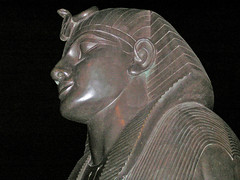
U1075219
Originally uploaded by kjk76_88
Four items of evidence have been offered to establish a connection between the Pharaonic era and the Roman Catholic Church. The Pope’s miter, or ceremonial hat, looks like it was modeled on the crown that marked the Pharaohs of the Upper and Lower Kingdoms. Artistically, it is the biggest and most attention-getting crown in history.
The crook of the Pharaonic statue (crossed with the flail, a ceremonial whip) is echoed in the shepherd’s crook held aloft by Bishops and the Pope as a symbol of spiritual guidance.
The word chosen to punctuate Christian prayers, “Amen,” is a reminder of the Egyptian sun god, Amun, or Amun-Ra.
Finally, the heroic circular plaza of St Peter’s, at the heart of the Roman Catholic Church, features an Egyptian obelisk in the center of the magnificent space. It was installed by Pope Sixtus V in 1586.
There’s one more connection which I saw presented in the Coptic Museum, Cairo (the Coptic Church is an ancient branch of the Christian faith that became Egyptian rather than Roman): it is that the ankh, symbol of life, is a predecessor to the cross.
Much of what we discuss relates to fine art. Let us follow the thread and find the many additional ways in which the art and life of the pre-Christian Egyptians and the Roman Catholics are similar.
photo: Bishop Montini holding mitre and crosier, is shown in the presence of Cardinal Tisserant (left) after being consecrated by Pope Pius XII in ceremonies at the Vatican, 1954.



























